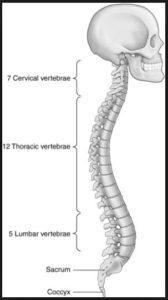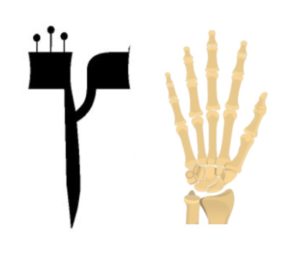God In Your Bones
When God created the human body, He left His “fingerprints” all over it. This is perhaps most clearly seen in the skeleton. The adult vertebrae has 26 bones. The thorax also has 26 bones (24 ribs, plus the sternum, and hyoid in the neck). Each foot has 26 bones. The skull has 26 bones, too. (The skull is sometimes said to have 28 bones, however the two bones of the maxilla, or upper jaw, fuse into one before birth, while the mandible, or lower jaw, is technically a separate entity, being the only bone in the head that is movable and detachable.) It is intriguing how this “stamp” of 26 is found across the skeleton, 26 being the gematria of God’s Ineffable Name (יהוה). (Incidentally, 26 is also the “English gematria” of God, since the letter g is the 7th of the alphabet, o is the 15th, and d the 4th, making 26!)
The same number is found multiple times within the measurements of our DNA, which is 26 Å wide, and which is composed of a sequence of nitrogen bases which are spaced 0.26 nanometers apart. On that note, 26 is the atomic number of iron (Fe), which has 26 protons in its nucleus. Iron is particularly special because it is the most stable element on the periodic table, and the most abundant metal in the universe. Iron courses through our veins, supplying vital oxygen to every cell of our bodies. Each red blood cell has over 1 billion iron atoms inside of it. It is literally what makes our blood red. And those special blood cells initially form within the bone marrow of the skeleton.
 The most important part of the skeleton is undoubtedly the vertebrae protecting the spinal cord. The bones of the vertebrae are divided up as follows: 7 cervical bones, 12 thoracic bones, 5 lumbar bones, plus the sacrum and coccyx. Atop the vertebrae is the cranium housing the brain. It is amazing that this configuration perfectly parallels the 27 symbols of the Hebrew alphabet, the “building blocks” of Creation according to Kabbalah.
The most important part of the skeleton is undoubtedly the vertebrae protecting the spinal cord. The bones of the vertebrae are divided up as follows: 7 cervical bones, 12 thoracic bones, 5 lumbar bones, plus the sacrum and coccyx. Atop the vertebrae is the cranium housing the brain. It is amazing that this configuration perfectly parallels the 27 symbols of the Hebrew alphabet, the “building blocks” of Creation according to Kabbalah.
Sefer Yetzirah, one of the most ancient Jewish mystical texts, explains how the Hebrew alphabet has 3 “mother” letters (aleph, mem, shin), 7 “doubled” letters (those that have two sounds: beit, gimel, dalet, khaf, pei, reish, tav), and the remaining 12 “elemental” letters. In addition, there are the 5 letters that have an extra symbol when appearing at the end of a word. The Kabbalists called these special 5 the gevurot, the “strict” ones, or by their acronym, menatzpakh (מנצפ״ך). So, the 7 cervical bones correspond to the 7 doubled letters; the 12 thoracic bones correspond to the 12 elemental letters; the 5 lumbar bones correspond to the 5 gevurot; and the sacrum, coccyx, and cranium appropriately correspond to the 3 mother letters.

The letter aleph is made up of two yuds and a vav. Each yud has a value of 10, while vav has a value of 6, making a total of 26.
Each one of the letters neatly parallels a specific bone. For example, the first letter aleph is for the cranium which houses the brain. The shape of the aleph (two yuds connected with a vav) represents the two halves of the brain, connected by the bundle of nerves called the corpus collosum. As mentioned, the cranium itself has 26 interconnected bones within it, just as the letter aleph has the inner value of 26 within it (the gematria of those two yudsand a vav).
 Interestingly, the 27th and final symbol of the Hebrew alphabet is the tzadi sofit, which the Arizal says has the shape of a human hand and fingers (see Sha’ar HaPesukim on Balak and Matot). It is therefore most fitting that the official number of bones in each hand is 27! On that note, at birth a baby has a total of 270 bones. As the baby grows, certain bones fuse together so that an adult human has 206 bones. As stated earlier, 206 is the gematria of davar (דבר), God’s Word, through which He created this universe, and the amazing details of the human body.
Interestingly, the 27th and final symbol of the Hebrew alphabet is the tzadi sofit, which the Arizal says has the shape of a human hand and fingers (see Sha’ar HaPesukim on Balak and Matot). It is therefore most fitting that the official number of bones in each hand is 27! On that note, at birth a baby has a total of 270 bones. As the baby grows, certain bones fuse together so that an adult human has 206 bones. As stated earlier, 206 is the gematria of davar (דבר), God’s Word, through which He created this universe, and the amazing details of the human body.
This is one reason why the righteous Job said, “And from my flesh I will see God” (Job 19:26). God left His undeniable imprint on our bodies. One need only take a closer look.


1 comment:
Shavua Tov! Fascinating! Thank you.
Post a Comment